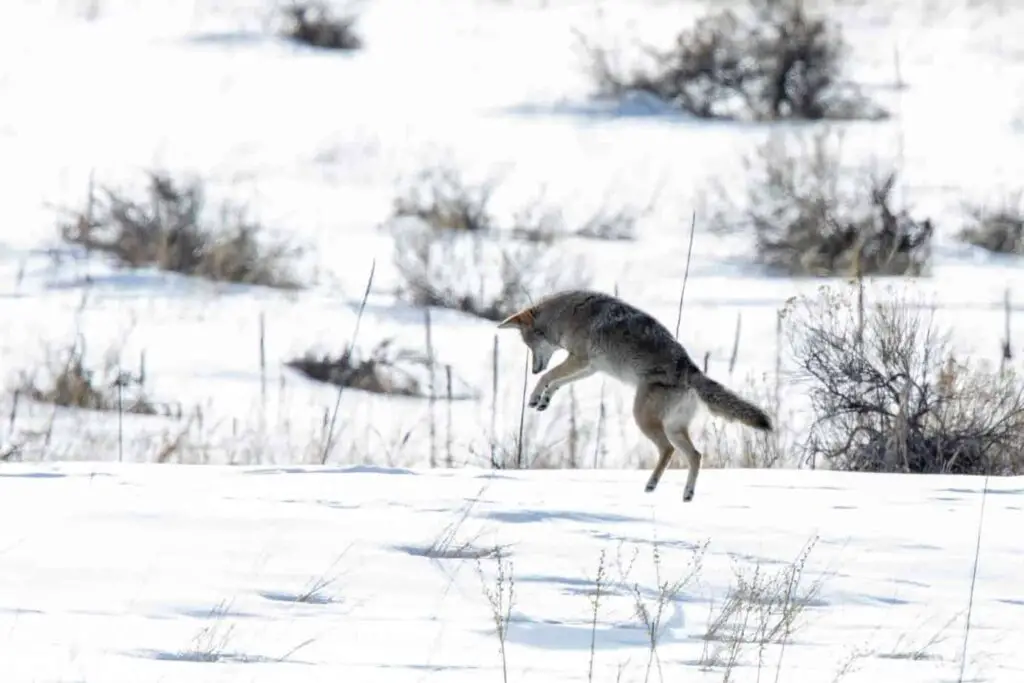Do coyotes hunt in packs? If you google this, you will find a host of poorly written articles that proclaim coyotes do hunt in packs. Why? Well, someone has let their guard down and allowed bloggers with no experience to write lengthy articles they know nothing about.
I’m a professional coyote hunter. Coyote hunting is something I do every day, teach to thousands of people every year, and write books about. Want to keep a coyote as a pet? Don’t! Want to know what eats coyotes? Alive? Absolutely nothing! Want to know how to hunt coyotes at night? I’m your guy.
Only a fool who has never seen a coyote, let alone studied them, would suggest coyotes hunt in packs. In the world of professional coyote researchers and hunters, the use of the word “pack” all by itself implies a total lack of knowledge about the subject.
I can only imagine what these silly bloggers have to say about how to handle suburban coyotes, or what will happen after the gray wolf returns to New York.
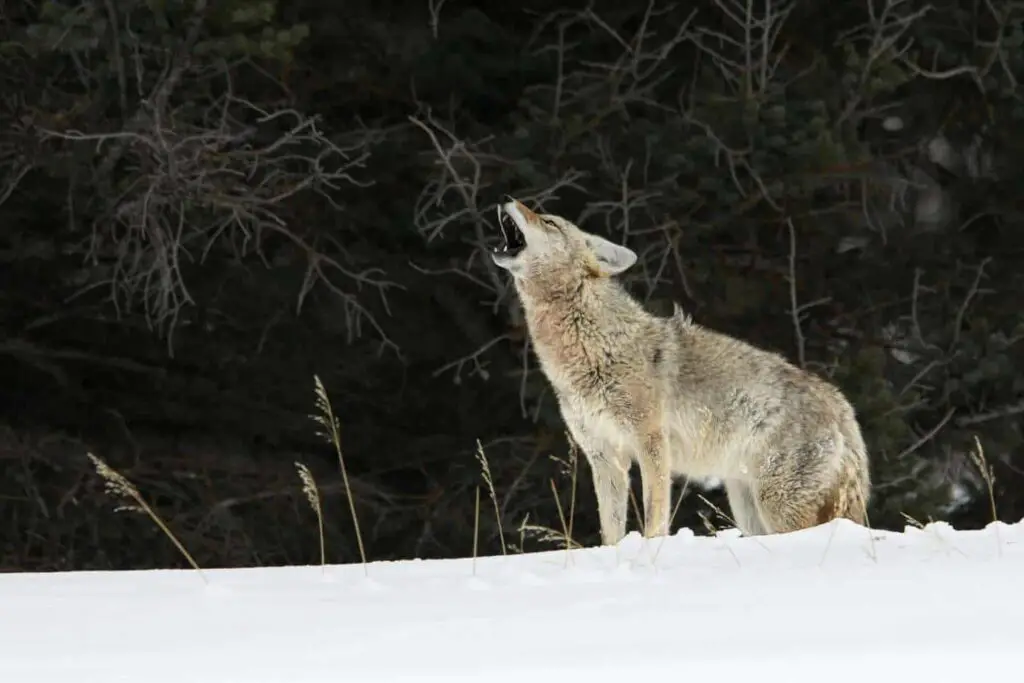
Do coyotes hunt in packs?
Coyotes never hunt in packs; they hunt alone or with one or two family members. Coyotes are ambush predators, carefully stalking and pouncing upon unsuspecting prey. Most larger prey taken by coyotes are sick or injured and require no pursuit, coordination, or collaboration.
That coyotes do frequently hunt and travel alone is one of the key differences between them and wolves. While a wolf may sometimes hunt by itself, their social structure and the prey they pursue normally mandates the larger numbers of a pack.
In order to understand why coyotes do not hunt in packs, you need to know what coyotes are, what they eat, and how they live their family oriented lives.
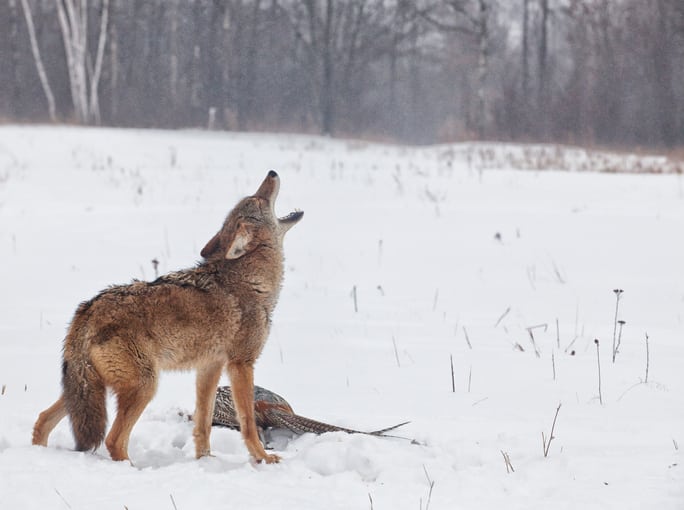
What is a coyote?
A coyote is an undomesticated canine native to North America. Its slender muzzle, bushy, low-hanging tail, and pointed ears resemble a camouflaged German Shepard. Intelligent, highly communicative, and designed to adapt and thrive in almost any environment, a coyote is also surplus-killing predator.
The scientific name for the species” Canis latrans” means” barking dog.” There are 19 known subspecies of the coyote. The Canis latrans var (more familiarly known as the Eastern Coyote) is the largest of the subspecies.
Coyote fur colors are varied, often geographically, but predominantly light gray or brownish yellow patches mixed around its body with black and white. A coyote’s eyes are yellow (a domestic dog usually has brown eyes). A coyote’s tail sometimes has a black tip at the end and is constantly carried low when moving at any speed (unlike domesticated dogs).
Coyote tracks are often straight lines (compared to a dog’s meandering path) and are narrower and more elongated than a dog’s. Related: Learn how to read coyote tracks and scat.
Western coyotes have an average weight between 20-25 pounds, while the Eastern Coyoteaverages between 25-45 pounds. The largest coyote ever recorded topped the scales at 75lbs.
Why there is no such thing as coyote packs.
Coyotes live as either solitary animals or members of a family unit. They don’t form groups of unrelated (genetically different) members.
The solitary coyote is nearly always a transient (a traveling coyote looking for a home), a family member out hunting alone, or a dog that has lost its mate.
Coyote family units comprise an alpha male and an alpha female (father and mother), plus several offspring. The offspring in the family will mainly consist of the most recent litter, with one or two older female helpmates from a previous litter.
Coyotes mate for life and build independent families, not coyote packs.
Coyotes mate for life. The mate selection process is meant preserve the genetic line, ensure the two are suited for a lifetime pairing, and will provide a strong parental unit for future litters.
Coyotes choose their mates by first listening and responding to each other’s calls. A male enters a female’s territory and follows her as she hunts. Unless rebuffed, he will increase his interactions with her—laying close by, playing, grooming, guarding, and eventually copulating when she is ready.
Interestingly, whether or not the female becomes pregnant, the pair will still look for a location for a den. Some researchers believe female coyotes who will not bear become pregnant still display maternal behaviors and activities and physical signs like nesting and swollen bellies.
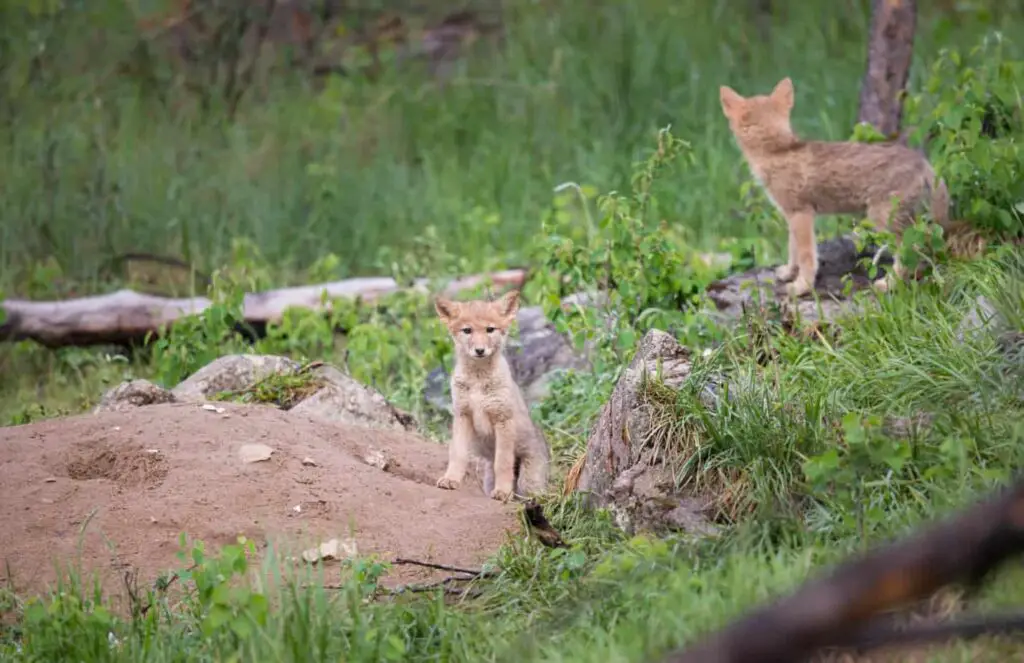
Life as a coyote parent.
Coyote parents have about one year to get their pups born, reared, and released alone into the world. While they do a remarkable job caring for their young, only about 30% survive their first year in the wild.
Contrary to popular belief, the number of coyote pups born in a litter is not affected by food availability or death rate (such as from hunting or trapping). Only the mother’s fertility determines the number of pups she gives birth to. Coyotes have no news networks, information sources, or magical abilities to sense increases or decreases in overall coyote population numbers.
Preparing a coyote den.
After mating, the pair must find a place to bear and raise the future litter. The coyote gestation period (60-63 days) gives them roughly two months to finish the job.
It is the female coyote’s job to do all the digging and alterations. She may dig an entirely new hole, expand an abandoned badger, skunk, or other animal’s den, or use a rock outcropping or hollowed-out tree. The shelter will be located near a water source, have good drainage, and sport a southern-facing opening.
While the female prepares the den, the male will guard her and bring her food. Again, whether genuinely pregnant or not, the female will be the male for regurgitated food, and he will provide it.
Other than when she is hungry, the female will avoid contact with the male. In most cases, she will not exit the den until about ten days after the pups are born. At this time, she will start taking short trips away for water and food for herself.
Most coyotes will dig at least two dens to provide a safe backup in case of detection.
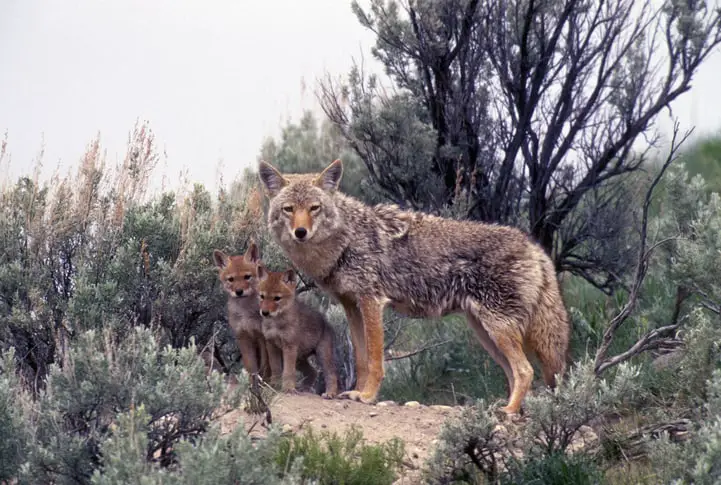
After the coyote pups are born they are fed by the family, not by coyote packs.
Newly born coyote pups are blind and helpless but constantly protected and attended to by their parents.
Within ten days, the pups’ eyes are open, and they start exploring their home. For the first six weeks or so, mom provides them with milk. After weaning, she will regurgitate food for her pups and then introduce a variety of dead rodents for them to eat. Before they finally leave their home, live rodents will be provided to help the pups learn how to kill their own food.
Life as a new coyote pup.
Within 35 days of birth, a coyote pup starts exploring the world outside its den. Everything will be new and different for the next few months, except for its parents’ constant presence and oversight.
The pup is moved to a new location soon after being weaned and able to kill and eat its own small prey. After providing the perfect sanctuary, the den is abandoned, and never to be returned to by this pup.
Training coyote pups to hunt alone: Why people think coyotes hunt in packs.
To prepare it for its new lifestyle, mom and dad will take it to areas like meadows with tall grasses and the edges between tree lots and open plains. Here the pups will tag along their parents on short hunts.
Human observations of coyote parents accompanying their young is why some mistake these family groups for packs. For a while, coyote parents and pups are always within sight of one another. With time, they will start temporarily leaving their parent’s side and testing their hunting skills independently.
Once the pup has reached nine months of age, it is ready to survive on its own. This is just in time for its parents to start work on ready things for the next litter. The parent’s next step? Kicking the now adult pups out of their territory.
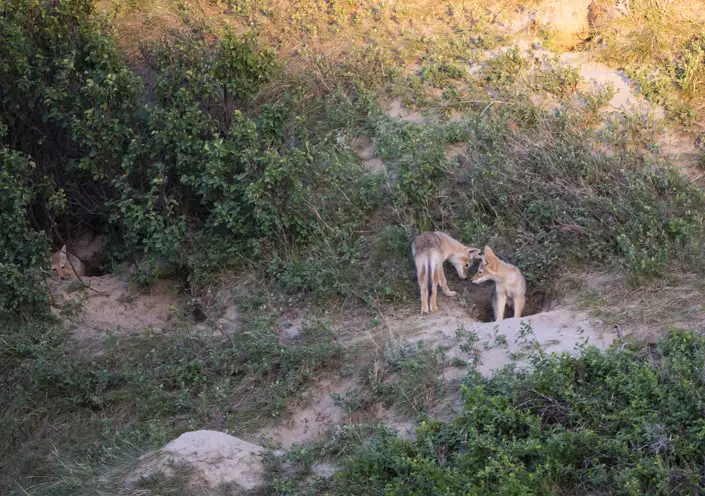
Coyote pup dispersal season.
In most of the United States, adult coyote pups are forced out of their family units by September. Far from helpless and trained to hunt and kill by their parents, these young adults will eagerly begin the process of finding territory and mates.
After pup dispersal begins, coyotes are rarely seen in number greater than two, and spend almost all their time hunting alone.
While some females may remain behind, all males are forced to leave to prevent inbreeding. The remaining females will spend the next year acting as helpers to raise the next litter.
Coyote pup dispersal season is noted for one thing in the United States, the sudden appearance of numerous roaming Individual coyotes—and dozens of local news stories warning the public of the danger.
Much of the information, and many of the human-coyote interactions, are filled with misconceptions and, often, mere myths.
Diet: Why it’s wrong to claim coyotes hunt in packs.
Let’s take a look at the diet (stomach contents and dung) of a few coyotes in different states within the United States. As will be proven, the majority of a coyote’s diet does not require a pack of coyotes to secure it.
What do coyotes eat in Kansas?
Kansas coyotes eat many mammals, with nearly 98% of the coyote scat studied containing mammals during the winter months (dropping to 72% in summer).
Of those mammals, the eastern cottontail was the most common (found in 63% of the winter scat samples and 46% of the summer samples). Voles, rats, and mice were also found, but the exciting discovery was in the amount of coyote scat containing whitetail deer. Only 1% of summer coyote dung had any deer, and only 15% of winter coyote scat.
During the summer, 33% of the scat had some fruit (wild plums in particular), and 60% contained insects (with grasshoppers again being the most common).
What do coyotes eat in Texas?
Texas coyote hunters, brace yourselves. According to research on coyotes living in the Texas Rolling Plains region, fruit made up 46% of coyote scat in the early 1970s. While rodents topped the five most common menu items in that area (with rabbit at # 3), mesquite pods, juniper berries, and opuntia fruits came in at numbers 2, 4, and 5, respectively.
As you can see, most of what a coyote eats ether doesn’t require any hunting at all, or can be done alone. The fact is, coyotes do not hunt in packs because their diet has never required them to learn and utilize such a skill.
